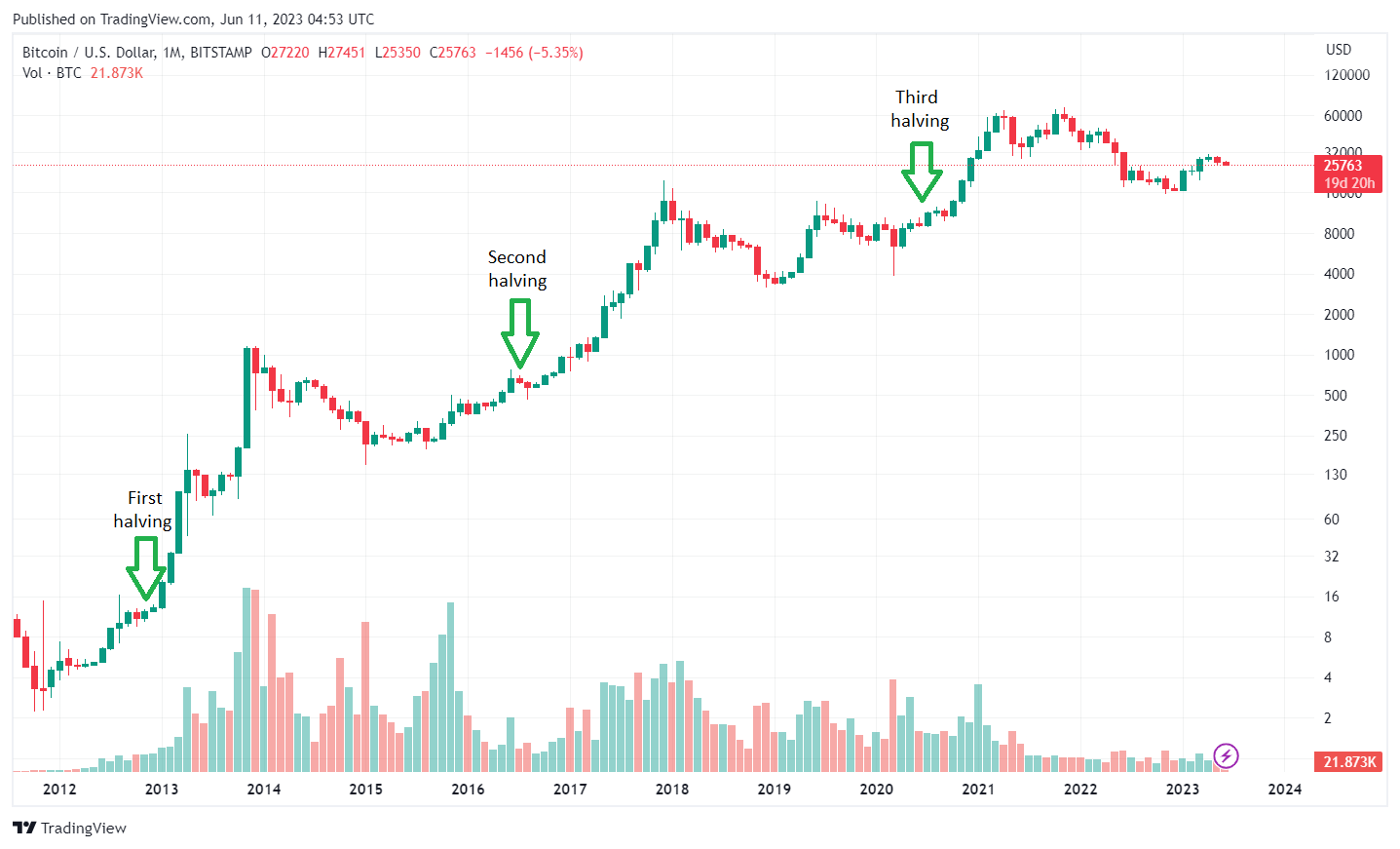It’s felt like an eternity since Bitcoin and many other cryptos hit their all-time highs – nearly two years – after dealing with a prolonged bear market.
Despite a strong start for various crypto assets earlier this year, with BTC, ETH and others getting a ~50% boost in March and April, prices have failed to continue climbing and sustain a break-out.
With the upcoming 2024 Bitcoin Block Reward Halving (<300 days); the growing probability of a Bitcoin Spot ETF being approved in the USA; Ripple winning its lawsuit vs the US SEC; ongoing upgrades across multiple blockchains, and much more, extremely bullish activity is closer than you think.
Here is a list of the top 12 signs that you are well ahead of the general population in preparing for the next market-wide crypto bull run.
1) You see the bigger picture and think long-term.
Late 2024 going into 2025, is expected to be an incredible time for the crypto space if history were to repeat itself.
Major market fluctuations barely phase you anymore; in the beginning, watching your portfolio 10x and then drop down to about 1.5x your original investment makes you regret not taking more profits….
Then you consider the medium- to long-term performance of assets such as BTC, ETH, BNB, MATIC, and – to a lesser extent – XRP and where these are expected to go in the next five to 10 years.
Whilst you take some profits here and there, you still maintain plenty of skin in the game and weather the recurring storms across the crypto space.
You’ve got diamond hands (💎 🙌) and HODL through thick and thin, a stark contrast to the paper hands that get readily spooked at the slightest thought of the market crashing once again.
I have included a logarithmic price chart of BTC/USD since 2011. The general trend speaks for itself. As a reminder, past performance is not a guarantee of future results. Still, when you factor in the bullish signs I identified earlier, coupled with ongoing network improvements, there is a strong probability of a new BTC all-time high in 2025, shortly after its upcoming halving.

2013, 2017, 2021…2025 new ATH? Source: TradingView (arrows and text added by the author). Snapshot taken on 11 June 2023.
2) You remain informed and obtain information from numerous reputable sources.
– No shills/charlatans
– No narcissists and overt displays of (crypto) wealth;
– No (sometimes not-so-obvious) scammers/MLM promoters;
– No BS about the illusion of “guaranteed returns”;
– No lack of transparency;
– No maximalists that insist on constantly mocking other projects; this guy is my favourite.
As per the latter, there are a few Bitcoin maxis that I still respect as they are articulate and grounded people with a strong belief in an asset that I also think will do well – Michael Saylor, Anthony Pompliano and Jack Dorsey, to name a few.
Besides all of the scammers, s&#tcoins and some nasty people in mainstream media who think they understand crypto but insist on tarnishing it, you’ve also gotta do your research.
For starters, it would be great if more people understood these things:
– Bitcoin mining is no longer bad for the environment due to its energy intensity, so please keep up the times before you continue peddling this BS outdated claim. Read this piece if you’re still unconvinced.
– Ethereum stopped using proof-of-work (PoW), i.e., relying on crypto mining, about 12 months ago and began its transition to proof-of-stake (PoS) in December 2020 via The Merge.
– Ripple is not XRP. They are closely linked but two separate entities.
– Crypto is not primarily used by criminals, which I will expand on later in this piece. As public blockchain explorers can readily trace various crypto transactions, and blockchain analytics companies such as Ciphertrace and Chainalysis (more on the latter later on) constantly monitor crypto networks for fraudulent activity, Bitcoin, Ethereum and several others are very transparent networks.
3) You diversify but do not spread yourself too thin.
Pick 2-3 crypto assets (5 max) and focus on those; BTC and ETH should be major players in your profile if you plan to invest in this asset class for a while.
Dabble in others and do sufficient research on the projects you invest in. Still, you gotta take profits accordingly,
This leads me to my next point.
4) You have a clear exit strategy.
Your profits are never truly realised until you take them, whatever way you choose to do so.
For most of us, this will involve taking a significant chunk of profits in a local fiat currency (USD, EUR, GBP, AUD, etc.) and assigning that money to other investments.
For others, this could come in the form of converting altcoins into BTC and using that to buy a physical asset such as real estate or similar tangible investment.
Regular traders will find stablecoins (USDT and USDC being popular options) useful to take profits and wait for BTC or an altcoin to drop in value and buy back into the market to gradually stake satoshis.
During an insane bull run, everyone feels like a winner (including chucking money into s&#tcoins) until the market comes crashing down, and you witness your profits dropping faster than Terra Luna’s price, per se.

Never underestimate an abrupt market crash after an incredible bull run. Image by Wit Olszewski on Shutterstock.
5) You understand how to take profits, not just in fiat but in crypto-to-crypto trading pairs.
Whilst most of the space – particularly beginner and intermediate-level crypto enthusiasts – consider crypto-to-fiat trading pairs (e.g., BTC/USD, BTC/EUR), you also see the potential in boosting your balance in your preferred crypto when trading it against another decentralised digital asset.
I wrote a dedicated article about this matter earlier this month; click the link below to check it out.
https://medium.com/crypto-insights-au/the-bitcoin-and-ethereum-charts-that-most-ignore-83b85339dbc4
6) You prioritise using non-custodial wallets and interacting with reputable exchanges when required.
The “not your key, not your crypto” mantra polarises people in the space, with some interpreting this as a hardcore approach to keep your crypto (i.e., private keys safe).
From my experience being actively involved in this space since 2017, this still holds water, but I have to admit that the exchanges I have used have always kept 100% of my funds safe, and I have been able to access that about 98-99% of the time.
Having said this, non-custodial wallets were, are and will remain the most secure option, albeit less convenient than centralised exchanges (CEX). That 1-2% downtime on a CEX (an arbitrary figure FYI) can occur when you want to access your funds, so be mindful of that.
For perspective, for most of us digital natives, NCWs have become increasingly simple to use + more trustworthy and reliable choices are hitting the market, so you should be able to find at least one option that suits your needs.
Ledger and Trezor have historically been market leaders in this facet. Still, Ledger’s massive PR faux pas since their Ledger Recover move has led to other (preferably open-source alternatives) to boost their market share.
On this note, I recommend using a BitBox02 device, which is open-source and has a secure chip in it.
FYI, this is not paid advertising, but if you use this link to buy a wallet at no extra cost, I receive a small commission, which helps support my writing work.
As always, do your own research to see what works best for you.
Here is a summary of what’s worked for me regarding reputable crypto exchanges.
7) You regularly invest in crypto, even in small amounts.
Dollar-cost averaging is one of the most popular strategies adopted here – invest the same amount at regular intervals regardless of the asset’s price.
Whatever amount you can afford to assign to BTC, ETH or another major asset, even a tiny amount, it is still better than a zero balance and spending years sitting on the sidelines contemplating what could have been.
Wanna see how much you could have made using the DCA strategy to invest in BTC and ETH since 2018? There is an article for that too.
 Image by VitaminCo on Shutterstock
Image by VitaminCo on Shutterstock
8) You understand that the vast majority of crypto transactions are for legitimate purposes.
And this is supported by independent data, so anyone claiming otherwise and trying to tell porkies to tarnish crypto should shut the f$#k up by now.
Cut the nonsense about how much crypto is used for illicit purposes. The average person with little understanding of cryptocurrencies and distributed ledger technologies (blockchain, directed acyclic graph, etc.) gives others the impression that much of the crypto space is used for criminal activity.
Yes, it obviously is, just like fiat currencies are also used as payment methods for illegal activities.
However, what percentage of overall cryptocurrency transaction volume between 2017 and 2022 is used for illegal purposes?
0.24%. For context, this is the second-lowest percentage during that period.
Yes, it is double the amount from 2021 (0.12%), and this trend must be reversed to go back towards 0.00%.
Despite the very low proportion, Reuters led its January 2023 story titled ‘Crypto crime hits record $20 bln in 2022, report says’, about Chainalysis’ The 2023 Crypto Crime Report, which is where I obtained the 0.24% stat (see page 7 of that report).
Whilst this is true – and I acknowledge, it is a disturbing amount of money – they conveniently ignored the 0.24% to emphasise the $20 billion record amount instead.
Meanwhile, Coindesk ran a similar story but had the decency to offer an impartial view on this and acknowledge both the % and $ value rather than conveniently ignore the % drop in illegal transaction volumes using crypto.
Media can opt to report one side of the story that favours their narrative, but we should also do our due diligence and look for sources with balanced arguments. This goes for everyone: crypto haters, sceptics and those unscrupulous crypto shills on the other side of the spectrum.
As a bearer of some good news on this front, Chainalysis provided an update earlier this month via their blog. Here is an excerpt from a related piece:
Through the end of June, crypto inflows to known illicit entities – not including inflows to entities that have been sanctioned or subject to special measures – are down 65% compared to where they were at the same time in 2022.
Chainalysis blog, 12 July 2023.
As we migrate to an increasingly digital world, we all need to be savvier and keep alert for scams all around us, particularly as they become increasingly sophisticated. Check out this information about how to keep your crypto and general online data safe from hackers.
9) Variety is the spice of life, not just what you invest in but whom you follow in this sector.
Earlier, I covered the groups of people to avoid in this space.
What about those you should follow to ensure a well-rounded understanding of crypto?
Since 2017, crypto commentators – the good, the bad and the (literally) ugly – have come and gone. However, many have stood the test of time and still deliver regular content 100% free on video streaming and social media platforms.
The Modern Investor, Thinking Crypto, Ivan on Tech and Coin Bureau are my favourites at the time of writing. However, I recommend many other entertaining and insightful people in the space; more info about them is in an article I wrote in March.
Some focus on Bitcoin or another crypto; others concentrate on technical analysis; certain individuals offer a great mix of entertainment and knowledge; from the article, as mentioned earlier, you will discover a blend of excellent people positively contributing to this space.
10) You understand how staking works and how to use it to its full potential.
Staking Rewards is one of the best sites when dealing with PoS cryptos, and we are looking to capitalise on the best staking ROIs available.
Whilst running your stake pool is an excellent way to further boost your crypto holdings beyond simply delegating to one of these pools, everyone should be delegating PoS assets (at least a decent portion of one’s holdings) so that you can earn new crypto by staking your funds to help run a PoS blockchain network.
Since Ethereum’s full migration to PoS since The Merge last September, PoS assets now represent the majority of crypto assets by circulating market cap.
As ETH no longer uses mining (PoW), remember that the only way to earn new ETH is to hold and delegate it.
11) You follow and invest in crypto-related stocks, particularly BTC miners.
This further adds to diversification in the space by gaining indirect exposure to crypto via companies that hold BTC and/or are involved in BTC mining.
These publicly-listed entities have significantly outperformed most crypto assets, not just in the top 200 but even 95% of the top 500 crypto assets by circulating market cap year-to-date.
Iris Energy Limited (IREN), CleanSpark (CLSK), Marathon Digital Holdings (MARA), Hive Digital Technologies (HIVE) and other Bitcoin miners have blown most other stocks and digital assets out of the water so far in 2023.
Their expanding operations and measures to prepare for the upcoming Bitcoin halving whilst ensuring that most of their energy requirements are derived from sustainable energy sources (nuclear and renewables) across various power stations in North America make them well-positioned for robust growth in the coming months and years.
Check out this article that covers publicly-listed Bitcoin miners and another one outlining other ways to invest in crypto and blockchain technology indirectly.
For context, the priority should be to hold crypto assets directly; many investors obtained an excellent ROI on these crypto-related stocks in 2023.

Photo by Michael Förtsch on Unsplash
12) You understand that Bitcoin has been the best performance asset over the past 12 years.
Even though many altcoins have exploded in price since their launch, Bitcoin still boasts the best ROI since its humble beginnings of less than a penny per BTC (yes, you read that right).
As a picture tells a thousand words, I will let this chart from Charlie Bilello do the talking.https://twitter.com/charliebilello/status/1680278970699227137
Asset Class Returns since 2011… pic.twitter.com/zZowZcAsTH
— Charlie Bilello (@charliebilello) July 15, 2023
Source: Charlie Bilello on Twitter
Final thoughts
I realise that some of these might go against certain values people have about crypto, particularly puritans that insist on holding only one digital asset – usually BTC, ETH or even XRP – and only using a non-custodial wallet.
Perhaps the idea of getting behind a publicly-listed (centralised) entity does not bode well with you, and that’s fine; you do you, as long as you are happy with your decisions and are sufficiently/fully aware of the pros and cons associated with them.
This piece aims to equip you with the most important information you need to know to prepare for whatever happens in crypto, whether the market goes up or down.
I know I could (perhaps, should) have covered small-to-mid-cap altcoins that could skyrocket in price and possibly do a 50 or 80x, but my priority has shifted to blue-cap crypto assets nowadays, as I focus more on the long-term.
If you want more info about small-cap crypto gems, I recommend Ivan on Tech, who covers this a lot through his educational content and related service, Moralis Money.
Happy crypto investing and I believe our patience will massively pay off sometime in the next 15-20 months; not too long now…
Affiliate link: Get $40 off your next crypto tax report with Koinly! This is not paid advertising, though I receive a commission for any referrals made with this link.
Disclaimers
- B. None of this is financial advice; I am not a financial advisor. You are solely responsible for crypto investments, let alone in any asset class.
- The opinions expressed within this piece are my own and might not reflect those behind any news outlet, person, organisation, or otherwise listed here.
- Please do your research before investing in any crypto assets, staking, NFTs and other product affiliated with this space.
- For transparency, BTC and ETH (combined) account for about 45% of my crypto portfolio at the time of writing.
Featured image by nuttapon averuttaman on Shutterstock.